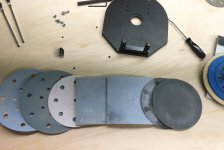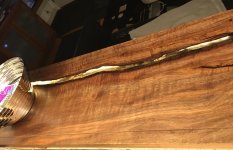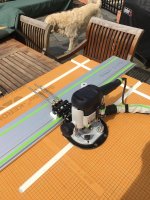samsmith93
Member
- Joined
- Nov 24, 2021
- Messages
- 30
Hi,
I recently purchased a used RO125 having seen them used extensively for resin projects.
I am building up to making a large table, however in the meantime I have been making some resin serving boards (30x50cm approx) to practice on.
The boards are made, they have been through the planer thicknesser, but now it comes to the sanding, and I am having some issues with my rotex.
Clearly the sanding action of the rotex is very powerful, but the issue i am having is that my pads seem to 'gum up' really quickly. I also am getting noticeable swirl marks, of a much larger grit than the pad i am using (so I am presuming this is from the stuff that is adhering to the pad). I have been starting at about 120 grit and working up to 3000 (120, 200, 320, 400, 600, 800, 1000, 1500, 2000, 3000).
I have watched quite a few videos and 'how to' guides, including the helpful festool live sessions and the Larry Smith stuff. I dont have a festool vaccum its attached to a shop vac (via a cyclone), and I have read a lot about how I need to reduce the suction and so I have this turned all the way down.
I am using it in rotex mode (as that is what the festool people suggested as it has more of a polishing action) and I find that seems to be better than the RO mode.
I am hoping for some guidance and help!!!
The boards I have tried so far are West Red Cedar, but I have some oak boards too - however I have not tried it on them yet as it takes me about 20 minutes to clean all the pads up with a brush after ive used them.
The finish on the wood is acceptable, but the finish on the resin is poor. They were poured over 20 days ago so are fully hardened.
Thanks in advance for any help that anyone is able to give me.
I recently purchased a used RO125 having seen them used extensively for resin projects.
I am building up to making a large table, however in the meantime I have been making some resin serving boards (30x50cm approx) to practice on.
The boards are made, they have been through the planer thicknesser, but now it comes to the sanding, and I am having some issues with my rotex.
Clearly the sanding action of the rotex is very powerful, but the issue i am having is that my pads seem to 'gum up' really quickly. I also am getting noticeable swirl marks, of a much larger grit than the pad i am using (so I am presuming this is from the stuff that is adhering to the pad). I have been starting at about 120 grit and working up to 3000 (120, 200, 320, 400, 600, 800, 1000, 1500, 2000, 3000).
I have watched quite a few videos and 'how to' guides, including the helpful festool live sessions and the Larry Smith stuff. I dont have a festool vaccum its attached to a shop vac (via a cyclone), and I have read a lot about how I need to reduce the suction and so I have this turned all the way down.
I am using it in rotex mode (as that is what the festool people suggested as it has more of a polishing action) and I find that seems to be better than the RO mode.
I am hoping for some guidance and help!!!
The boards I have tried so far are West Red Cedar, but I have some oak boards too - however I have not tried it on them yet as it takes me about 20 minutes to clean all the pads up with a brush after ive used them.
The finish on the wood is acceptable, but the finish on the resin is poor. They were poured over 20 days ago so are fully hardened.
Thanks in advance for any help that anyone is able to give me.





